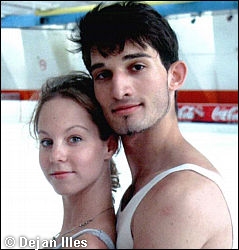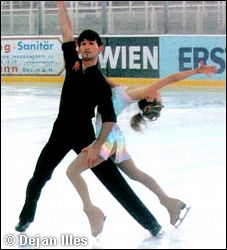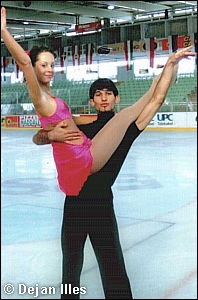Talking to the Hungarian Team
Series part 1
| Hungary is having quite a team of skaters these last years. Most of them still train in their own country and not abroad. As a special project, Adastra, Helga, & Kati went to the Jégcsarnok icerink in Budapest, to talk to several of them for Absolute Skating, as well as for Pixieworld. Not only skaters will get the mike, but also some coaches. Some interviews were in-depth, others were mostly focused on fun. All interviewees filled out the same 'fluff' questions and choices at the end. Join us for the first part of this marvelous series! |
 |
1.3 Dejan Illes
by Adastra
& Helga Dobor
Photos © Adastra
& Dejan Illes
 |
Dejan Illes, the Croatian-Hungarian ice dancer is a charming young man and a talented skater. He is slim, but muscular, and has dark hair with blond highlights and smouldering dark eyes. He resembles Edvin Marton, the Hungarian violin player. My first impression was that he's a very relaxed
person and this impression remained with me. We laughed
a lot during the interview. |
How did you get started in skating?
It was my parents’ decision, because my sister danced
and skated when she was younger too. My sister quit though
because my parents were not well-off at the time - and this
sport requires a lot of money.
Twelve years later, I was born. My parents wanted somebody
from the family to continue this sport and they could afford
it then, so they took me on the ice.
The first time I went on the ice, I mainly stood and held
on to the boards. Coaches told me not to compete, because
I was too old for skating. Almost all the coaches told me:
No. Then I met Ilona Berecz, and she told me that those children
who fall a lot could be great skaters when growing up. So
she took me under her wing. Two months later I had my first
partner, Hajni Oros, and we won the Novice Nationals six months
later. After this event, they said that I was really talented,
and so my skating career began.
Where did you live at that time?
I started my career in Hungary. I represented Hungary for
4 years. At that time I danced well, I worked hard and we
got good results, but it wasn't worth skating in Hungary,
because we didn't get the support (neither training camps
nor skates).
We had to cover all costs of skating ourselves, and it wasn't
cheap, especially training with a coach at an international
summer camp. All skaters should, when they reach a certain
level, attend training camps where they can develop new skills
and elements.
Fortunately I have dual citizenship, Croatian and Hungarian,
thanks to my mother, who is Croatian. Therefore Croatia suggested
to switch countries. Croatia hadn't had ice-dancers for a
long time and they would have been able to support and promote
us - and we could revive ice dance there. So Hajni Oros and
I said yes and we began to represent Croatia.
 |
Did you compete as a single skater? I used to be a single skater - I mean I tried it. It was compulsory. The dancers had to take single skating lessons. We learned many technical elements and the jumps too. We had to get used to the ice and we learned the technical elements, which we can use as pairs or ice dancers. I have never competed as a single skater. What is your best result? I placed 18th at Worlds with my former partner, Kamilla Szolnoki at senior level. |
How old were you then?
I was 17. Unfortunately Kamilla got injured two weeks before
the Olympic Games. So we didn't have any chance and lost all
our hopes. I was very disappointed afterwards and I didn't
know what to do next, while Kamilla quit skating. I couldn't
decide whether to go on with skating or not, but thanks to
my friends’ encouragement about continuing skating,
I opted to continue.
After a year break, I continued with a new partner. She also
was Hungarian. Her name is Andrea Major.
We represented Croatia, but unfortunately she quit skating
last year.
|
Why did she retire from skating? There were many things going on in her life, for example
her studies kept her from concentrating on skating. |
 |
Which parts of your skating do you want to strengthen?
In this sport you can't reach the technically best position because you always have to learn new things. That is why the training camps are so good, because you think you skate well but when you go a training camp - bang! - a Russian skater sweeps past next to us. I think I am good now technically, perhaps because I had no partner and I could concentrate on myself. I can work now on twizzles and change of edges etc. At this level I have to develop my presentation, of course not forever, but I still need it..
Presentation is a very important part in ice dance, but how difficult is to be both an artist and an athlete?
My opinion is that the competition is art and the training is sport. We work very hard in training. During the season we practice about 10 hours a day. In a competition you can’t see all this; a year’s work to create a perfect performance in 4 minutes.
Which is the best?
Wow...I like both of them. A skater can perform well if he/she has good technical skills. The two things relate to each other. Maybe I would like to perform as the best artist on ice, since perhaps the audience would not notice the mistakes in a good program.
Do you have favourites or idols in skating?
Yes. I really like Anissina & Peizerat. In my opinion,
ice dance changed, partly because of them. I trained with
them in training camps between 1999-2001. Their coach, Muriel
Boucher-Zazoui taught us there and that’s why Gwendal
Peizerat taught us, too. For example, they showed us how we
could easily do the technical elements in compulsory dance
using little tricks/cheats, to make it easier, without the
requested steps, and so on.
So my favourite ice dancers, the dancers I looked up to, are
Marina Anissina and Gwendal Peizerat. I liked learning from
them and I would like to skate as well as them.
Afterwards, they quit, as did Lobacheva & Averbukh, the
Lithuanians, the Russians, the Israeli team and the Canadian
pair. These pairs were excellent and I miss them.
Who were placed at 15-16th, then? Now they are in the top
ten, however they skate like in the past. That's why I can't
look up to them as I could to A&P.
What are your goals and plans for the future?
Recently my goal is to get back to the level that I was at before. I don't want to say that I want to be world champion or Olympic champion - that’s quite an overused phrase, and it depends on many things, not just our skating. I'd rather finish in the first 10-15 places, and skate at that level a while, improving my choreography. After my eligible career, I might launch out on an enterprise, live with my family and a dog in a house...
What is your skating style like? My style? I'm not a dancer who likes the waltz. I prefer the tango and Latin-American dances. I like using my body. The waltz is a bit boring to me, because people dance it with very serious faces - but I'm not such a person. I'm said to be a little crazy during training, because I am always fooling about. But at least I can survive the 4-hours long training. |
 |
Which are your favourite programs?
I mentioned the style I like, but I like the more serious styles too. For example, we skated to Romeo and Juliet. It was a very good program - a foreign choreographer and a Hungarian coach made it up. It was a successful program. Although I feel the Latin-American dances are much closer to me, ie the cha-cha-cha, samba or the Argentinean tango.
So do you prefer these dances to the original dances?
Yes, I do. Now in the original dance there is the Tango Romantica. Perhaps it is the most difficult dance among the originals, but I love it very much! Fortunately I learned this dance from Marina and Gwendal, and from their coach, Muriel, as it was the original dance at the Worlds that year when we practised together.
I have heard a question about rock and roll and swing dancing possibilities on the ice.
You can dance these on ice. This will show the talent and technical knowledge of the skater, and how good an artist the skater is, how well he or she interprets the music. We go also to ballroom dance and jazz ballet, and then we can start to try these dance steps on the ice. It is very difficult but it is still possible.
Do you usually manage to do it?
Sure. That's when the dance teacher or choreographer comes into play. He has an idea that he tried off-ice. And then he tells us his instructions. The problem is we have to do these moves on the ice, so we have to adjust them to the ice. The result will be almost the same, the only difference is we're gliding on ice. The performance is really important because the dance has to look like just as you're dancing it off-ice.
Who would you choose among the female Hungarian ice dancers to be your partner?
It's a difficult question, because in ice dance the most important thing is how you match with your partner. You could say that you like this or that girl, and even that she is a good ice dancer, but that doesn't mean you would be the perfect couple together. In Hungary there are only two girls I can mention, Zsuzsanna Nagy and Nora Hoffmann who have the right technical knowledge and physique. But it depends on more things that I would choose...
Internationally, who would your choice be?
Well, I don't know. The dancers who compete at international competitions are all very good technically. I wouldn't choose according to technical ability but I would choose by performances. I would like her to be a good performer and a laid-back girl. But I can't tell you names as there are too many good female skaters.
 |
Yes, that's, the point now, that we should have more, and not only one ice dance couple, but at least two, who could go to the international competitions and could achieve better and better results. It is still a long way off and it also depends on the Federation, the management and the sport politics. This process can't happen in one year. But something has finally started and let's hope this process will continue.
|
I've heard some opinions from the female ice dancers - that they lead in the dance, and not the men. Is it true?
I don't allow the girl to lead! For example my first partner
danced better than me. I got her as partner because she could
advance me to her level. So she had to lead me, because I
was only stumbling and I was falling all over the place. After
I reached her level, my coaches told me : "You are the
guy, you have to lead."
And I'm the character who doesn't like when the girl leads
on the ice!
This caused lots of problems with my former partner. We argued
a lot, because she was very stubborn, and if she wanted to
go in a direction, then we had to go in that direction. She
tried to drag me to that place. And I, for that very reason,
wanted go in the other direction, so we had a wrestling-match
in the short program. Somehow, with difficulty we made a compromise.
We decided when she leads and when I lead in the program,
so finally we were able to solve this problem. Usually I lead
in dancing - at least I try this.
The ladies say this, because they think that the judges watch the ladies more?
It was true a while ago...about six years ago. Then the
role of a man was that he stayed behind the girl, lifted her
up and walked away, lifted up her again and walked away again...like
in the ballet 40 years ago. But this passed quickly in skating
because the man plays an important role in ice dancing.
The judges watched the ladies more then - their beautiful
costumes, their movements, their performing, and they didn't
notice the man in the background. Then they found out that
they also have to watch the man, so they made lots of requirements:
the spins, steps, movements, artistry elements must now be
applied to the men.
Nowadays there are more and more judges who rather watch the
men. Some of the men don't get accustomed to leading, because
they aren't so laid-back or don't perform enough well. Now
the judges say: we score the couple down, because the man
doesn't do anything. So men have to pay attention to their
movements. The judges now watch us 50/50.
Some fans think this is the case with Hoffmann & Elek or Navka & Kostomarov for example…..
Well, it is the problem for Hoffmann &Elek, but I am
not criticising. Nora Hoffmann has an out-going personality.
So Attila Elek isn't as noticeable with her. Nora shakes her
body, plants herself in front of the judges and smiles at
them and so on. She dominates more than her partner.
Anyone could have this problem skating with Nora. She needs
a partner who is taller, graceful but strong and laid-back.
And it would be a very good couple because both would be skilled
in performing and in technical knowledge.
And what about Annisina & Peizerat?
Yes, they were very professional. Although they disliked each other, they didn't make it public. They usually only met at training. They didn't talk to each other except while training. They didn't go to the same places, they avoided each other. That was their professionalism. Their work was skating so they didn't quarrel on the ice, they worked hard, and fought for their goals silently. If after training, off the ice, they bawled and fought with each other, it was their life and their coach didn't have a say in it.
 |
What do your friends or another people think about that you skate? Figure skating and ice dancing are very feminine. It's
a typical opinion. We (my friends and I) often go out
and meet other boys and girls. We start to talk to them,
and of course they ask what we do for a living. We reply
that we are sportsmen. And the next question: which
sport do you do? And our answer: we are ice dancers.
Their next question usually questions our sexuality.
Although it may seem to be a „feminine”
sport, sexuality is not an issue when it comes to creativity.
|



